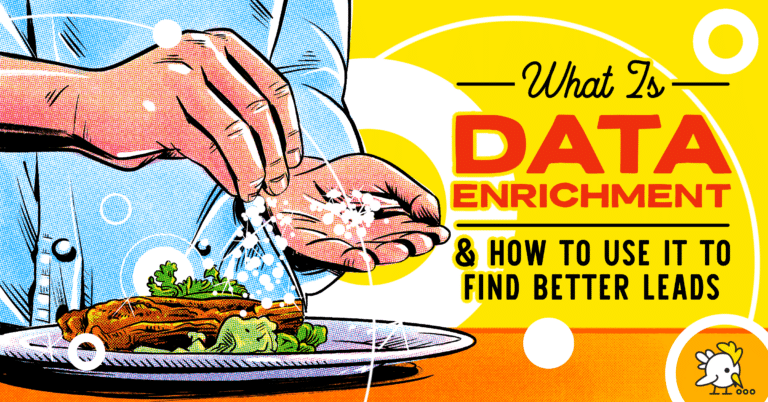Data is the lifeblood of most businesses today.
Before you even launch your brand, you’ve likely extensively researched your industry, your competitors, and the market overall. And once your business is up and running, analytics are your best friend when doing everything from optimizing your site to deciding what products to offer next.
And while the data that you’re able to collect internally is obviously exceptionally useful, especially when it comes to helping you see what’s currently happening with your business, it has blind spots that can be hard to see. For best results (and your best chance at scaling), you’ll want to look at data enrichment options.
In this post, we’re going to dive deep into data enrichment, including what it is, why it can be so valuable, and how to use it to connect with higher-quality leads and make more sales.
What Is Data Enrichment?
Data enrichment merges your data, which comes from internal sources like your Google Analytics or customer surveys, with third-party data from external sources.
This is not purchasing data like industry benchmarks and comparing your own analytics against it to see where you’re measuring up. It’s much, much more specific than that, offering detailed information about individual customers or leads.
Instead, it may take the form of acquiring new demographic data about your existing customer or lead base, like their age, income level, education, job title, or even marital status. You now have more information about existing leads, which is direct and actionable, allowing you to improve your marketing, sales, and lead-nurturing messaging.
What You Can Learn from Data Enrichment
There are a number of different things you can learn from data enrichment that can help you score your leads, including the following:
- Demographic information about individuals. Get information about your leads’ age, gender, education, job title, and more. In addition to lead scoring, this can also help you fine-tune your marketing strategy with more relevant copy, offers, and messaging. While it varies, B2C businesses may benefit most from data enrichment with demographic data.
- Information about a company. Company size, industry, income level, and more. For B2B businesses trying to identify decision-makers in their target audience, this can be a game-changer.
- Geographical information. For some businesses, location is everything. A cleaning service scoring leads, for example, will want to know if someone is inside their zones of service. In some cases, leads from certain areas (including regions, states, countries, or even neighborhoods) may be more likely to convert than others.
- Purchasing histories. This can include their purchase history with your brand, of course, but it can also look at past shopping behaviors. Some users, for example, are more likely to shop online than others, which can be great for eCommerce businesses. Purchasing behaviors can be valuable cues when it comes to lead ranking and nurturing, offering insight into how certain users make buying decisions.
The Different Types of Data Enrichment
Data enrichment can come in a number of different forms, so when you’re looking at data enrichment software, you’ll see a variety of information offered.
The most common types of data enrichment include the following:
- Socio-demographic data enrichment. This process enriches an existing dataset with demographic information like household income, homeowner status, and marital status.
If you want to learn about a lead’s highest level of education (or the type of car they drive), this is what you want to look for—just make sure that you’re choosing a database that’s providing the type of demographic information that you need. - Geographic data enrichment. This process adds geographical data to your dataset, giving you a prospect’s postal code, city, region, or country.
- Purchase intent data enrichment. Enriching your data based on a lead’s purchase intent can be wildly valuable for sales teams. Imagine gaining information that certain leads are actively in the market for solutions exactly like yours.
This may include information based on real shopping data, or the number of times they view a product. Scrape Google search pages to gather insights on which products or services your leads are researching. - App usage data enrichment. Some tools will provide insights into which apps customers interact with or what operating systems and devices are used to access those apps. This can be helpful for businesses that need to identify user preferences and apps they need to develop with their app developer, especially regarding integrations.
- Data redundancy enrichment tools. There are some tools that focus on data hygiene, and they’ll comb through your existing data and look for redundant or duplicate information.
-
What Is Lead Scoring?
Read more: What Is Lead Scoring?Lead scoring is the method of assigning points to contacts or potential prospects based on…
-
What is BANT?
Read more: What is BANT?BANT is an acronym that stands for Budget, Authority, Need, and Timeline. It is a…
-
What is lead qualification?
Read more: What is lead qualification?Lead qualification is a systematic process utilized by businesses to evaluate potential customers based on…
The Benefits of Data Enrichment
While some of the benefits of data enrichment are more obvious—particularly in terms of your sales team gaining actionable information they can use to drive more sales—there are some that are worth discussing because they’re not as obvious.
These are some of the data enrichment benefits brands should consider:
Potential Cost Savings
Data enrichment allows you to gain access to the information you need now that can benefit your business, but only information that you really need. You’re enhancing internal data with external data sources, as opposed to storing enormous amounts of data that you may not actually need.
Some businesses, after all, capture every bit of data they can grab, but it’s not always relevant or up-to-date; data enrichment and data hygiene go hand in hand to give you better data you can actually use, so you aren’t wasting money on endless data storage of information you don’t need.
Improved Marketing Campaigns (& Results)
The more information you have about your target audience, the better, because there is no one-size-fits-all approach—especially with B2B selling and marketing.
Data enrichment tools can provide exceptionally valuable and granular information about your target audience members. This means your team can learn more about your audience overall, and they can adjust their marketing campaigns.
They can also create more personalized campaigns with this information, which can be invaluable for account-based marketing strategies. You can also add customers to the correct audience segments and custom lists, allowing you to retarget them effectively across multiple marketing platforms—including with PPC ads and email campaigns—so you can hit them with relevant offers and messaging.
Generate More Sales
We’ve already mentioned this, but it’s so important it’s worth discussing in-depth.
More relevant, actionable data is like informational gold to your sales team. You don’t want to just invest a ton of money into marketing campaigns and call it a day; you want to better understand the leads and prospects popping up in your CRM so that your salespeople know how to move forward.
Higher quality data means each salesperson will come to the first interaction armed with data that they can use to better sell to customers.
Imagine having a salesperson talk to you about a new tool that’s exactly what you’re in the market for, and mention that it integrates with your current tech stack and it’s got some of the key features that you’re looking for. That would be hard to ignore.
This makes data enrichment tools well worth any cost because your marketing campaigns become more effective at driving leads to your business and your sales team is more effective at converting them. If you want to talk about ROI, data enrichment tools are hard to beat.
Improved Customer Relationships & Retention
When you’re able to market and sell more effectively to customers based on their needs and pain points, you’ve got a seriously happy customer on your hands.
You’re not only able to more efficiently nurture customers, but you’re also more likely to build stronger relationships with them. They’ll see the value of what you’re selling more immediately and more concretely because you really understand how to highlight the fact that it aligns with their needs.
Adapting everything from your sales pitch to your methods of communication based on customer preferences can mean a stellar long-term relationship and an improved customer experience, which is all the better for retention overall.
And that, of course, is all the better for profit and revenue acceleration.
Eliminate Redundant Data
Redundant data is a massive way to bleed money unnecessarily for any business. It addition to being expensive to store, it can result in revenue loss, customer loss, and potentially even a hit on your brand’s reputation.
Redundant data is, unfortunately, extremely common in organizations because they don’t have proper data hygiene measures in place, and aren’t sure of what data to keep and what to let go of—and how to find data that needs to be removed.
Data enrichment can help with that, as some data enrichment tools even specialize in looking for duplicate, redundant, or out-of-date data.
-
Lead Scoring vs Lead Nurturing: 7 Differences to Maximize Your Sales Funnel
Read more: Lead Scoring vs Lead Nurturing: 7 Differences to Maximize Your Sales FunnelManaging leads effectively means prospects move through the funnel efficiently, resulting in more conversions and…
Why Data Enrichment is So Crucial
There’s an idea that the more data you have, the better. In theory, that can be true, but this idea really seems to hit home when it’s actually “the more accurate, relevant, and actionable data you have, the better.”
In short, data quality matters.
Think about the lead generation and nurturing process. Let’s say you have 100 people who sign up for your webinar. Your marketing team hands off this list to your sales team, which has three people. How do you choose who to pursue most aggressively?
If you look at their files and you only have their name and email address, then you officially know three things: Their name, their email address, and that they were interested enough in the webinar topic to register. That may be it.
Plenty of lead magnet forms look like this for B2B brands:
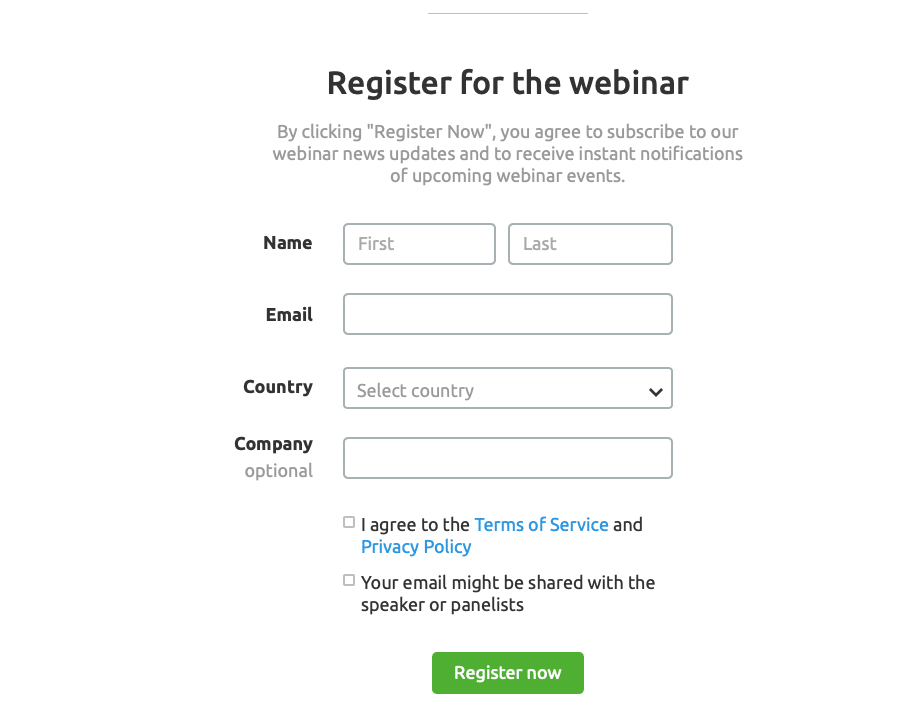
This is a decent start, but unless you’re directly familiar with the company, it ultimately doesn’t give you much to go on.
Here at Breadcrumbs, we’re of course all about lead scoring, which is the process of ranking leads based on different criteria to help identify who is most likely to be a high-value customer. This helps you decide which leads you want to really take the extra time to try to convert.
You can’t properly identify strong leads if you don’t have enough information about the leads that you have. A name and email alone won’t tell you anything; in this case, you’d need to rely on third-party data sources to enrich the information you already have, making it more valuable and more actionable.
How The Data Enrichment Process Works in the Age of AI
While there’s a lot of debate over the efficacy of different aspects of AI or certain AI tools in sales and marketing (hey, ChatGPT!), it’s undeniable that artificial intelligence overall is a huge asset to data enrichment.
In the age of AI, many data enrichment tools are relying on some form of artificial intelligence to increase the quality of the data they’re providing to you.
Plenty of databases, for example, can scan a lead’s profile and provide their location or their job title. That’s exceptionally valuable but relatively easy to gain information.
Where AI comes into play is offering more complex insights based on analyzing specific information about each customer, like their purchasing actions or specific traits. AI can provide information like:
- Purchase intent
- Sentiment analysis (or how someone feels about your brand or product overall or in a specific conversation)
- Primary topics of interest (often based on keyword extraction from conversations)
This information can be an enormous asset to sales teams, giving them insight that would be nearly impossible—or extraordinarily time-consuming—to narrow down without these tools.
How Data Enrichment Works: An Example
You can use data enrichment for a number of different purposes in your business, including improving your marketing campaigns. We’re going to give an example of how it can impact the lead generation and nurturing process.
Let’s say that you’ve developed groundbreaking new SaaS software that will give subscribers instant access to custom-for-them, computer-generated graphic designs as per recent trends. Knowing that many B2B businesses might pay $400 a month in graphic design fees, according to your research, you decide to charge $100 a month.
For major corporations, this is nothing. For many small- to medium-sized businesses, however, this is a big ask. They’ve often got tight budgets, and $100 a month can add up quickly.
You quickly realize that certain types of businesses (like those in the marketing, education, and wedding decor industries, all of whom make regular use of graphics) are more likely to retain beyond the free two-week trial. On the other hand, CPA Firm Bookkeepers pay for a single month to get any branded images for their site, and they’re out.
You also realize that businesses between 10 and 25 employees are your sweet spot; at that point, they have solid funding but haven’t scaled to the point where they have a designer on staff.
This is excellent information for lead scoring purposes. Your sales team can identify a marketing firm with 23 employees and know they have hit the jackpot.
But how exactly will they know that “Jake James, jakejames@gmail.com” belongs to that marketing firm with 23 employees?
What About Lead Forms?
Sure, you can absolutely ask this on a lead form; it’s not uncommon to see B2B businesses asking about industry or company size.
Some data, though, may be more difficult to get people to answer for a lead generation form.
I personally, for example, will not convert on lead magnets that I otherwise would have if it asks how much my business makes. I understand why they ask —it’s great lead scoring information—but I keep that information between me, my husband, and my accountant.
Lead forms like this are my worst nightmare:
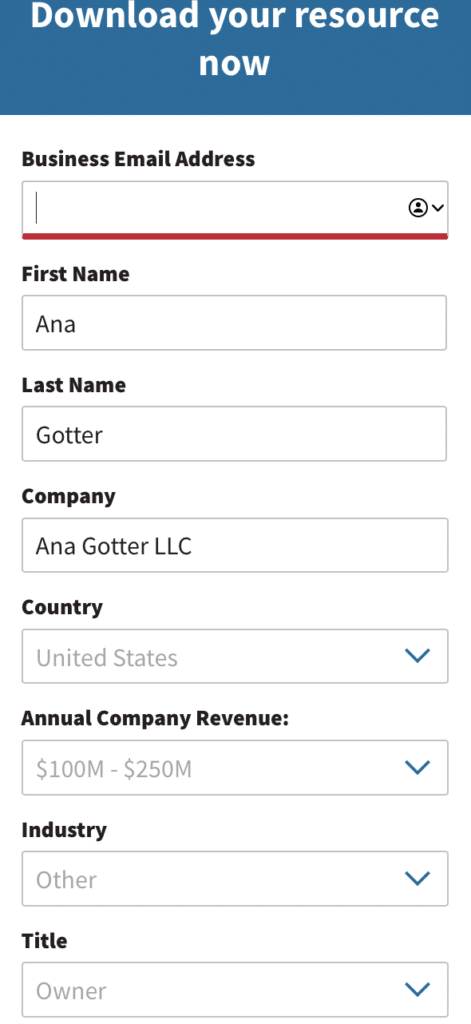
And I’m not alone.
I was recently talking to a friend who was looking into financial planners. She complained that she found one she liked, but that initial lead form (not even a personalized email) asked questions like “Do you have six months of living expenses saved?” and “What kinds of retirement accounts do you have?” She said it felt more like someone was trying to find targets to scam than clients to help.
It’s not just about lead forms that ask about financial status, of course. Many users aren’t going to be willing to leave personal information like whether or not they’re a homeowner, married, or parents on a random form.
And, in general, you don’t want to overwhelm potential leads with long, invasive lead forms. If they’re too long or they ask too much (or even a single question that the user doesn’t want to answer), you can lose them altogether.
This is where data enrichment comes into play. You can still get the information you need, and without potentially isolating and losing customers that could have been.
How to Apply Data Enrichment
At this point in the post, the value of data enrichment is pretty apparent. So let’s take a look at how to actually implement it.
In order to do this, we first need to answer one question…
Where Do I Get This Third-Party Data From?
The simple answer is “third parties.” I know, pretty vague.
There are multiple different data enrichment platforms out there that you can use that handle a lot of the heavy lifting for you.
They’re able to pull from third-party data sources of their own, giving you that perfectly merged and enriched data without someone on your team needing to use scraping methods (which can get you kicked off different platforms) or spending hours combing through the lead’s LinkedIn accounts.
How Breadcrumbs Can Help
Once you have all this great data—do you know what to do with it and how to prioritize it?
That’s where Breadcrumbs can help!
Here at Breadcrumbs, our lead scoring software makes it easy for your sales team to identify high-value leads that are most likely to convert. We integrate with most major CRMs, so we’ll pull the data that you’re already using (including enriched data) and help you make sense of it so that your sales team can act quickly.
We use a co-dynamic scoring approach so that you’ll be able to quickly assess leads based on both their fit and activity. Your SDRs will know exactly how a customer could fit into your business, and how best to approach them.
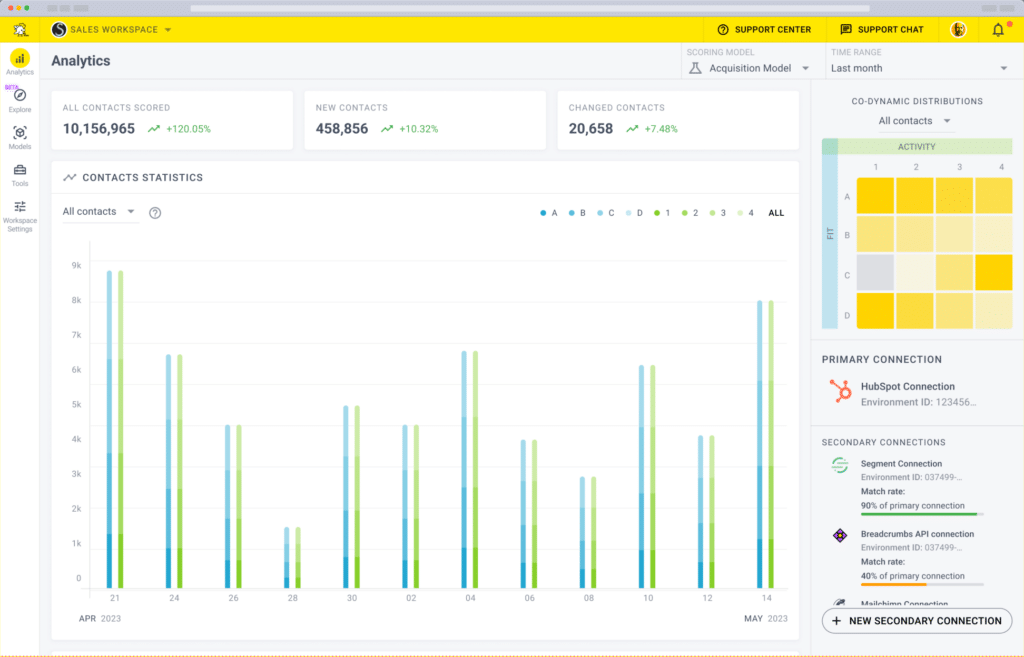
We’ll look at the data that matters most, and ignore what doesn’t matter at all. If your graphic design firm is looking for business leads, for example, it doesn’t matter if the leads are married, but it does matter how often they’re opening your emails or how large their marketing team is.
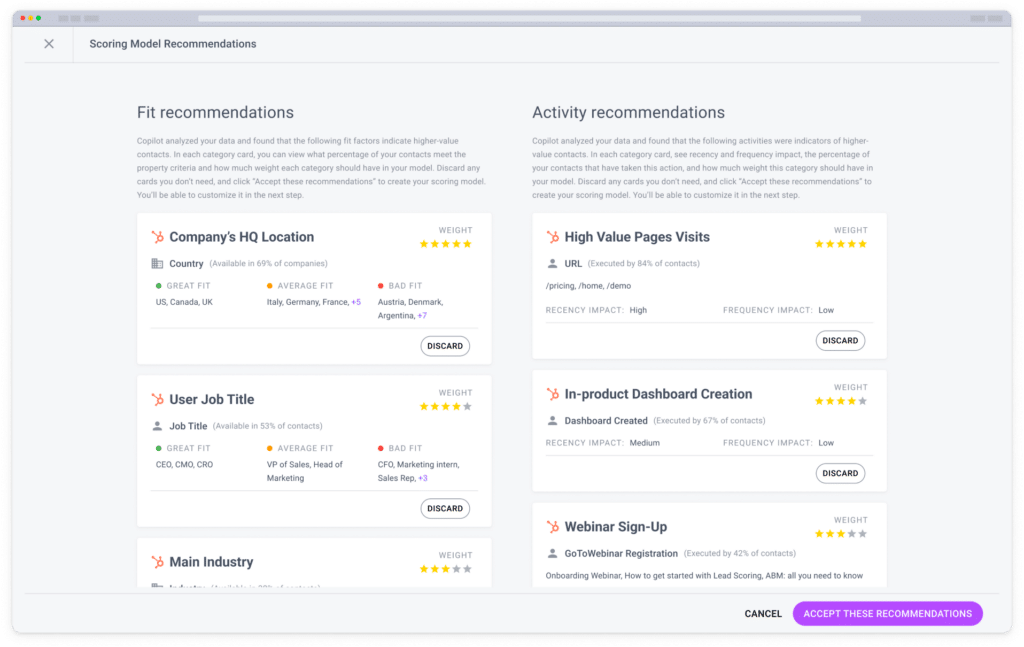
While all of our lead scoring models are fully customizable and testable, we also have the tools to help you get started fast!
Copilot will help you get started with your first lead scoring model in just a few seconds so that you can get up and running quickly. It’s simple—connect your data, run a Reveal analysis so we can learn about your high-value audience segments, and then get data-driven suggestions in the form of a lead scoring model that you can start testing immediately. You can learn more here.
Final Thoughts
When you’re trying to find new ways to scale your business, reach new audiences, and convert more high-quality leads, data is almost invaluable.
Sure, you need strong strategies, but the data can help you determine what lead magnets to create, what touchpoints to set up, what to ask on lead forms, and which leads are most valuable.
Data enrichment can help you realize not a certain individual is likely to be a high-value customer, but to identify high-value niches overall. This is useful for lead scoring, but it can also be useful for your marketing department, too; they can create resources and touchpoints designed specifically to attract users based on this information. Since businesses scale fastest when the marketing and sales team go hand-in-hand, this isn’t something you want to overlook.
And remember, too, that your marketing and sales teams are busy. Using a tool like Breadcrumbs can take the guesswork (and grunt work!) out of the equation. Your sales team won’t need to spend time trying to crunch numbers or sort through data; they’ll instantly have information about which leads should be targeted, so they can put every second of their time and energy into focusing on that.
Interested in seeing how data enrichment combined with lead ranking and lead nurturing can improve your entire sales process? Revolutionize your business’s lead generation process with Breadcrumbs. Book your free demo today.
